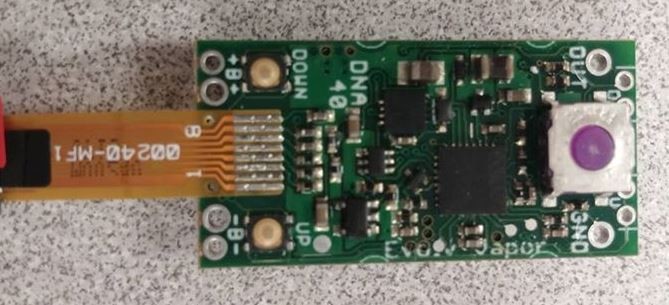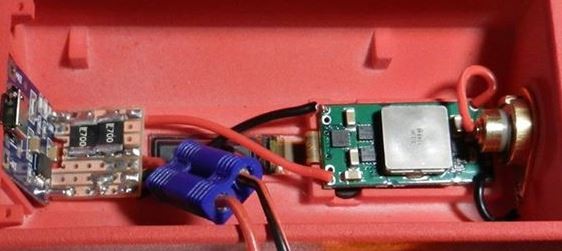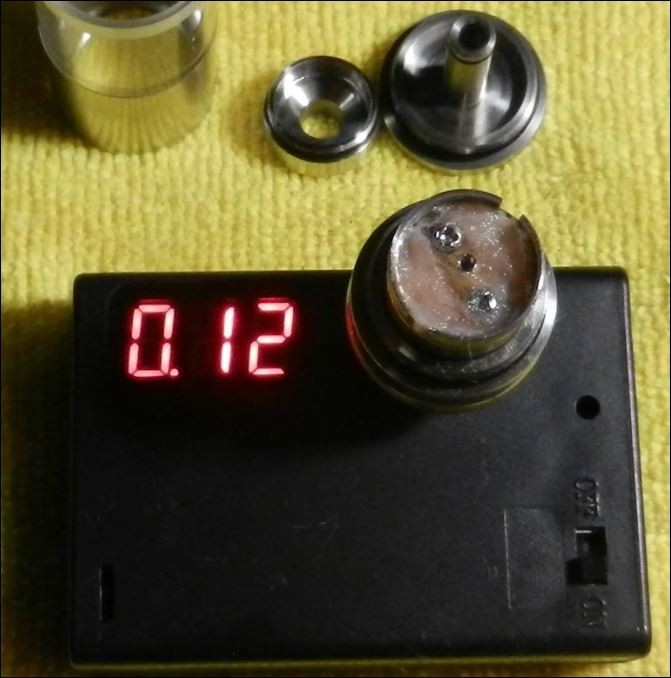Ok folks, I have been given the go ahead to open my mouth as of midnight. We were all told to wait until Phil Busardo posted his video,
As most of you know, I have been on the Evolv beta Team for this one and I have been testing the unit for several weeks. It has become my "go to" mod without doubt. By dialing in the temp to suit my juice and coil combo, I then get very repeatable hits, and no dry hits ever, even when dripping.
The new DNA40 from Evolv - 40 Watt Variable Power Module with Temperature Protection




Features:
The new DNA40 has all of the safety features of the previous DNA30 and finally adds reverse battery polarity protection to the mix! It also now has a “buck” circuit and can regulate as low as you want to go, down to 1 watt.
The big new feature though is “Temperature Limiting”. Yeah, I know..... "Why do I want it?"
Temp protection adds several nice characteristics.
In order to use Temp Protection you need to use NI200 (nickel) wire.
Commonly available at Temco,, some of you may know this as "non-resistance" wire used in some attys like the Ithika etc.

The reason it works is that NI200 has a known "temperature coefficient". In other words the coil resistance changes with temperature as the coil heats up. This relationship is known and well documented. The DNA40 constantly monitors the resistance while you fire and can then accurately calculate the temperature.
You can still use your old Kanthal builds, but you wont have the Temp Protection feature. The board will automatically sense whether you are using Kanthal or NI200.
Some other "good to know" things.
My personal experience has been very positive. I never liked drippers before because of the inevitable dry hit, but with this, you dont get them. It actually allowed me to warm up to drippers for the first time (well.... the Taifun dripper and S.O.D. atty helped). I tried a number of different attys, resistances, gauges of NI200, and coil types. What I saw is at 35-40w and 420ish degrees, the watts will start out high then quickly taper down as you achieve temp, the hit however was consistent from start to finish. The board was reliable, I had no issues whatsoever, however a few beta testers did encounter the 0 ohm issue that has been seen on the DNA20/30s as well. Disconnecting the battery to reset the board resolves this.
The official Spec Sheet:
http://evolvapor.com/datasheet/dna40.pdf
Check out Phil Busardo's video, it's about an hour long and has a good interview with Brandon from Evolv talking all about this new board and lots of info I may have missed.
As most of you know, I have been on the Evolv beta Team for this one and I have been testing the unit for several weeks. It has become my "go to" mod without doubt. By dialing in the temp to suit my juice and coil combo, I then get very repeatable hits, and no dry hits ever, even when dripping.
The new DNA40 from Evolv - 40 Watt Variable Power Module with Temperature Protection




Features:
- Input 3.1 to 4.3 volts
- Output 1vdc to 9vdc
- Max input current 16A
- 16A max continuous output current, 23A pulse
- Atty resistance (Kanthal) 0.2Ω to 2.0Ω
- Atty resistance (cold NI200) 0.1Ω to 1.0Ω
- Adjustable from 1 to 40 watts (Buck/Boost)
- Temperature protection adjustable from 200-600 degrees F
- Over/Under Voltage protection
- Over current protection
- Reverse polarity protection (finally)
- Battery monitoring with "soft limiting"
- New detachable side rails with screw holes for easy mounting.
The new DNA40 has all of the safety features of the previous DNA30 and finally adds reverse battery polarity protection to the mix! It also now has a “buck” circuit and can regulate as low as you want to go, down to 1 watt.
The big new feature though is “Temperature Limiting”. Yeah, I know..... "Why do I want it?"
Temp protection adds several nice characteristics.
- You will never get a dry hit.
- By limiting temperature, as your wick gets dry the coil will heat up and the Temp Protection will throttle back the watts to keep from overheating, consequently no dry hits, just weak “nothing” hits to let you know you need juice.
- You will not burn your sensitive wicks nearly as easily, imagine cotton lasting for weeks.
- If you set your temp below the melting/burning/deterioration point of your wick material, it wont burn.
- You can optimize the experience according to the juice you are vaping.
- Different juices, ratios of PG/VG, even flavorings and sweeteners etc vaporize at different temperatures. Heat them up beyond their vaporization point and you are cooking/caramelizing/burning/scorching them.
- In a traditional VV/VW build you could potentially heat your PG/VG up to the point where it decomposed and creates toxins. This gives you the ability to stay well below those thresholds.
- Your hit will be the same from the first second until the last!
- Whether you pause your draw, hit harder, hit longer, the Temp Protection will keep the heat the same throughout your entire hit. More airflow across the coil cools it and the board allows more watts, a pause slows the airflow and the board cuts back the wattage.
In order to use Temp Protection you need to use NI200 (nickel) wire.
Commonly available at Temco,, some of you may know this as "non-resistance" wire used in some attys like the Ithika etc.

The reason it works is that NI200 has a known "temperature coefficient". In other words the coil resistance changes with temperature as the coil heats up. This relationship is known and well documented. The DNA40 constantly monitors the resistance while you fire and can then accurately calculate the temperature.
You can still use your old Kanthal builds, but you wont have the Temp Protection feature. The board will automatically sense whether you are using Kanthal or NI200.
Some other "good to know" things.
- You need a battery capable of 16A continuous
- If you remove the mounting rails it has the exact same footprint as the DNA30, the buttons are also in the exact same location.
- The locations for the Up/Down/Fire button wires to hook up to the board have changed. All six button terminals are across the top of the board now.
- If you are accustomed to snipping off the fire button to save space, you will have to do things differently now. One option is to cut the button off as before then solder 2 jumper wires onto the board. The other option is to just pop the top cover off the switch, removing the button but leaving the base. The reason is because there are 4 terminals on that switch, 2 terminals on each side of the switch are by default an electrical short or path. The board uses this path, so if you totally remove the switch you are breaking the circuit.
- The mounting rails just snap off, but if you leave them on, there are 4 nice holes that you can put screws through to mount the board.
- Because the NI200 wire changes resistance as it gets hotter, if you fired the atty then removed it to refill or whatever, when you put it back on the coil is still hotter than normal. This means that the resistance will be higher and it would throw the boards calculations off. Consequently the board will ask you if it is a new coil or the same old coil. It remembers the last coil resistance (read on insertion of an atty at room temp) which is what is always displayed since the actual resistance is always changing as it heats and cools.
My personal experience has been very positive. I never liked drippers before because of the inevitable dry hit, but with this, you dont get them. It actually allowed me to warm up to drippers for the first time (well.... the Taifun dripper and S.O.D. atty helped). I tried a number of different attys, resistances, gauges of NI200, and coil types. What I saw is at 35-40w and 420ish degrees, the watts will start out high then quickly taper down as you achieve temp, the hit however was consistent from start to finish. The board was reliable, I had no issues whatsoever, however a few beta testers did encounter the 0 ohm issue that has been seen on the DNA20/30s as well. Disconnecting the battery to reset the board resolves this.
The official Spec Sheet:
http://evolvapor.com/datasheet/dna40.pdf
Check out Phil Busardo's video, it's about an hour long and has a good interview with Brandon from Evolv talking all about this new board and lots of info I may have missed.
